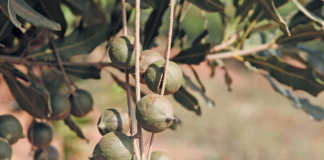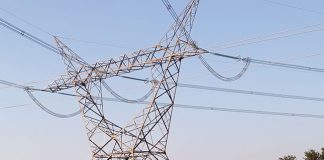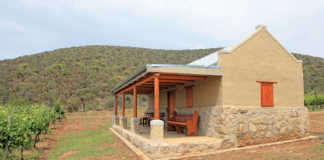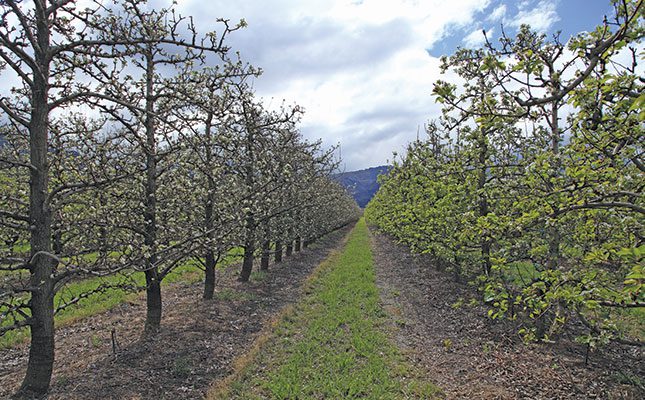
Photo: Glenneis Kriel
Over the past five years, GA Erasmus and Seuns Boerdery in Villiersdorp, in the Western Cape Overberg, has won the Two-a-Day award for the highest income per hectare with pears four times.
Last year it was with an average income of R363 993/ha. The company also won the Tru-Cape award for the highest income per bearing hectare.
READ Give your orchards the health coverage they deserve
When you ask owner George Erasmus to what he ascribes his success with pears, he wholeheartedly attributes it to the inputs and support of his production adviser, Nico Ferreira, of Two-a-Day’s Fruitmax Agri.
“I merely follow Nico’s advice. He had been assisting our farm long before I joined the business in 2012,” Erasmus says, and with that directs the conversation to Ferreira.
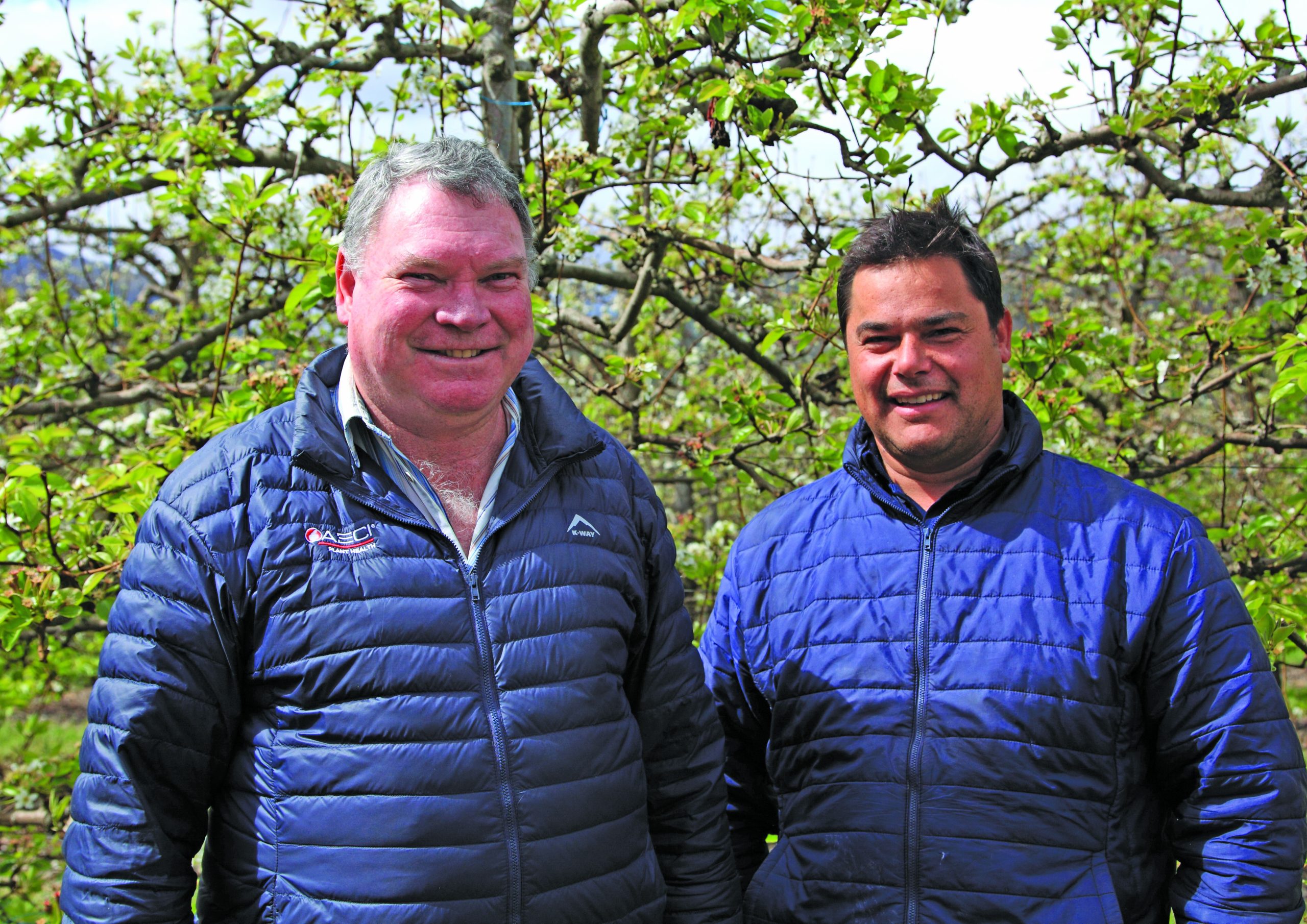
He, in turn, says that pear income per hectare greatly depends on the consistent production of good quality fruit. Erasmus’s target is to produce 60t of export quality fruit each year.
Orchards can be pushed to produce higher volumes, but Ferreira cautions that this would have a negative impact on fruit sizes, which in turn would lead to fewer pears being big enough for exports, and lead to alternate bearing.
If, for instance, you produced 120t/ha in this year, you might end up with only 12t/ha in the next year.
Big trees
But how does Erasmus achieve consistent quality? Ferreira explains that it starts with the creation of “large pear trees” through the use of healthy, strong plant material on vigorous rootstocks, such as BP1.
The trees are trained to a modified central leader to ensure good light penetration at all levels. They are placed on a four-wire trellis for support and to get good tree height.
The aim is to create a tree that is 4m high and 3m wide, says Ferreira. The orchards, between 13 years and 20 years old, are planted at 4,5m by 2m.
The trend is to plant closer, which should help to increase production per hectare. Closer spaced trees, however, would have to be managed even more intensely than these are to prevent the overshadowing of fruit.
READ Fruit sector research: power-generating trees, solar nets, and more!
Unlike apples trees that produce commercial yields from their third year after planting, pear trees only start to produce commercial yields from their fourth year.
Up until then, pear tree branches are tied down horizontally. If this is neglected, branches will grow upright, later leading to the overshadowing of fruit and subsequent colour and quality problems.
The trees receive higher volumes of fertiliser, and especially nitrogen, then mature trees to prevent any nutrient deficiencies and ensure the establishment of healthy, strong trees.
“Pear trees can produce good yields for more than 50 years if you look well after them, with the first few years from planting to production being the most critical. Problems during this stage can be difficult and costly to rectify later,” says Ferreira.
Management
During the fourth year after planting, when the trees are mature, management is shifted towards fruit production.
The trees are pruned during flowering in September, with all the big three- to four-year-old branches being removed in the process.
“We use renewal cuts and try to get most of the production from two-year-old wood, as these branches produce the best-quality fruit. The removal of the old branches has the added advantage of reducing crop load and improving light penetration within the trees,” says Ferreira.
Hand-thinning is done during blossoming in October, to remove any excessive leaves or branches that might negatively affect fruit colour or quality.
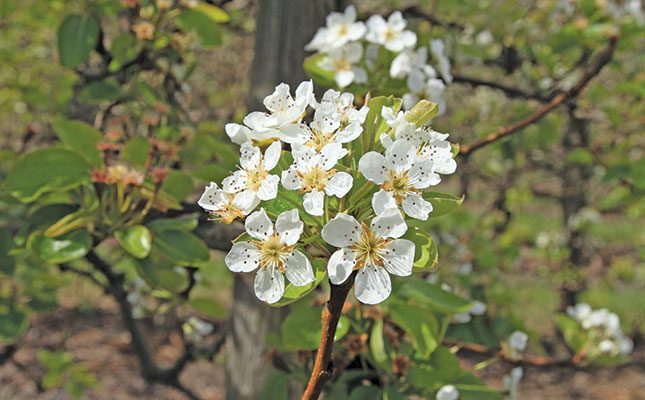
Ferreira identifies irrigation as another pillar of pear production success. Erasmus is in the fortunate position that his whole farm is irrigated under gravitation, which greatly reduces costs, as no pumps or electricity are needed to irrigate the orchards. In addition, he is not exposed to load-shedding.
“Without load-shedding, George can irrigate the orchards as needed. Some farms were without irrigation for 24 hours at times this year. Missing a day of irrigation in summer can cause a lot of stress to trees, resulting in poor growth and flowering. It is difficult to catch up, when you fall behind irrigation schedules,” says Ferreira.
The farm has sandy soils and Villiersdorp can get very hot in summer, so micro-sprinklers, instead of drippers, are used for irrigation.
These have the advantage of being able to deliver larger volumes of water over shorter intervals than drip irrigation, and have a bigger cooling effect on orchards.
The irrigation is scheduled and adapted according to soil moisture content, as indicated through probe measurements in different soil depths.
The probes work with short wave radio frequencies, so Erasmus physically goes to the orchards to upload the data onto a data logger. “This is a good thing as you still need to do physical inspections in the orchards,” he says.
Conservation farming
Fertilisation is based on the crop load, stage of production and leaf and soil analysis results. Soil analysis is done every three years, whereas leaf analysis is done annually towards the end of January.
Micro-nutrient deficiencies are addressed with foliar feeds, whereas macro-nutrients, such as nitrogen, potassium and phosphates, are broadcasted with a Red Ant spreader straight onto the planting rows.
READ Soil health: farming with nature, guided by science
Wheat straw is bought in from farmers in the Overberg to use as mulch on tree rows. The mulch helps to buffer the soil against extreme temperatures and reduce evaporation, and as it decomposes this helps to build the carbon content of the soil.
Erasmus has been experimenting with the use of cover crops, such as clover, medics and oats, which he plants in between the tree rows. He prefers to use perennials, because these do not have to be re-established every year.
“Each cover crop brings its own benefit, with a mixture of these said to have an amplifying effect. My results with the cover crops have not been that impressive so far, but I have only been doing it for a couple of years,” he admits.
Erasmus says that pears do not bruise as easily as apples, making them easier to pick. The trick is to mind the stem of the pears, as these may cause injuries.
Pest management is also easier than with apples. Their biggest challenge is codling moth, which is managed through mating disruption, and scab, for which they spray preventatively.
For more information, email George Erasmus at [email protected] or Nico Ferreira at [email protected].








